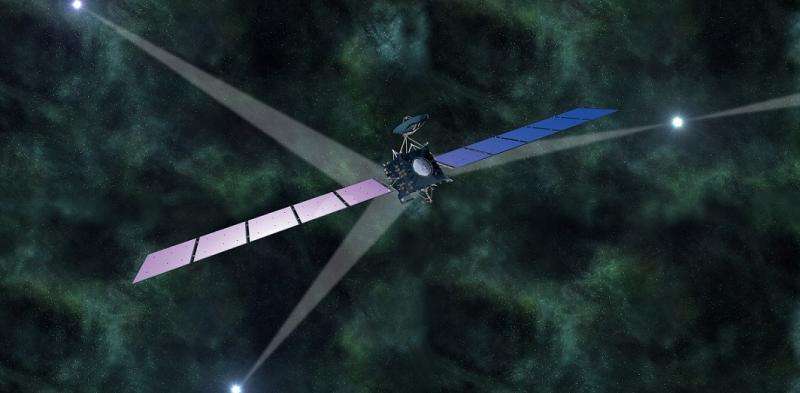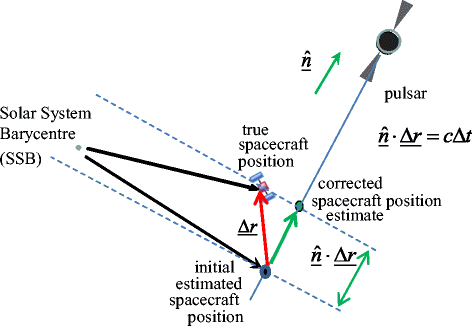Pulsar-based spacecraft navigation system one step closer to reality

Pulsars are highly magnetized, rotating neutron stars that emit electromagnetic radiation at regular intervals. They are often dubbed "lighthouses" of the universe as their emission is beamed; thus, the pulse of radiation is seen only each time the beam sweeps across the line of sight. A spacecraft navigation method known as XNAV, based on X-ray signals emitted from pulsars, has recently taken a leap forward, thanks to a study conducted by U.K. scientists from the National Physical Laboratory (NPL) and the University of Leicester.
Current spacecraft navigation systems rely on global network of large ground-based radio antennas like NASA's Deep Space Network (DSN) and ESA's European Space Tracking (ESTRACK). These networks require a spacecraft to communicate with ground-based systems for months or years, while XNAV would enable autonomous navigation, minimizing the necessity of communications with Earth. Moreover, the new method is expected to provide faster estimation of spacecraft location as current systems are limited by the time delay at great distances. XNAV is also seen as the cheaper alternative for radio-based systems, as it would require reduced ground infrastructure and because X-ray telescopes can be made smaller and lighter.
XNAV technology is currently in the early stages of development. In February 2017, NASA plans to launch the Neutron star Interior Composition Explorer (NICER) to the International Space Station (ISS), which will be hosted as an externally attached payload on the orbital laboratory. An enhancement to the NICER mission, the Station Explorer for X-ray Timing and Navigation Technology (SEXTANT) will perform the first space demonstration of pulsar-based navigation of spacecraft.
Meanwhile, ESA investigates the feasibility of the XNAV method. The agency commissioned NPL and the University of Leicester to develop potential design and determine the accuracy of this technique. As part of this task, a team of researchers, led by Setnam Shemar of NPL, has lately published a paper in Experimental Astronomy, detailing simulations that bring the new navigation system one step closer to reality.
"The work we have done is just one step towards understanding how a practical system may be realized and what its performance may be," Shemar told Astrowatch.net.
The paper describes simulations conducted by Shemar and his colleagues, using data such as the pulsar positions and a craft's distance from the sun in order to test the concept of triangulation by pulsars with current technology. These calculations allowed them to create a list of usable pulsars and measurements of how accurately a small and light telescope can lock onto these pulsars and calculate a location of a spacecraft.
"The simulations provided order-of-magnitude estimates of system performance. In order to implement a system, algorithms would need to be developed to take pulse time-of-arrival measurements of pulsars and use this information to derive a position of the craft," Shemar said.
The simulations made by the team provided crucial measurements regarding the future development of the XNAV method. The scientists concluded that at the distance of Neptune (about 30 astronomical units from the Earth), a 3-D location of a spacecraft with an accuracy of 18.6 miles (30 kilometers) can be calculated by locking onto three pulsars. Moreover, they estimated that even an accuracy of 1.25 miles (2 kilometers) can be achieved when locking onto a particular pulsar, called PSR B1937+21, for 10 hours. Due to the fact that PSR B1937+21 is a millisecond pulsar, completing almost 642 rotations per second, and thanks to its very stable rotation, it is capable of keeping time as well as atomic clocks.

The scientists noted that in case of a manned mission to Mars, where an XNAV system could provide valuable redundancy, observations of three pulsars, including PSR B1937 + 21, would enable a 3-D positioning uncertainty of approximately 18.6 miles (30 kilometers) for up to three months without the need of contacting Earth-based systems. This would require a total observation time of ten hours if using an instrument with multiple telescopes or two days with a single telescope.
According to Shemar's team, a great example of an instrument that could be used as an X-ray telescope for XNAV purposes is the Mercury Imaging X-ray Spectrometer (MIXS) that will fly onboard European-Japanese BepiColombo mission to the solar system's innermost planet. MIXS is designed to perform X-ray fluorescence analysis of the Mercury's surface. The researchers propose that this instrument could be further developed as a practical telescope for the XNAV system.
"We suggested the design of this telescope as a good roadmap for future XNAV studies as the mass power and volume are constrained in much the same way as an XNAV subsystem will be in the future. For other future missions, the study showed that the addition of an XNAV system could provide increased autonomy from the ground and also improved position knowledge at large distances from Earth," Shemar revealed.
However, major challenges still need to be overcome to develop this system as a 'GPS' in space, including the availability of a practical system, for steering the telescope to sufficient accuracy and reducing further the required pulsar observation times and the craft positioning errors. One limiting factor is the error to which the position of each pulsar in the sky is known.
"If, in the next couple of decades, these can be reduced by a factor of 10 using ground-based radio telescopes such as the Square Kilometre Array, then depending on the size and type of instrument used on the craft, and assuming the noise in the pulsar measurements is lower than the uncertainty contributed by the pulsar position error, it may be possible to get accuracies on the order of five kilometers (3.1 miles) at 100 astronomical units. This is roughly two-and-a-half times the distance to Pluto," Shemar said.
He added that even an accuracy of 650 feet (200 meters) would be possible in one dimension, but only along the direction of the pulsar PSR B1937+21. These errors would increase proportionately with distance.
The scientists emphasize that as well as X-ray, a practical instrument for radio observations should also be properly considered. Initially, a system may offer the most benefit in the outer solar system, particularly during the interplanetary cruise phase.
"Although pulsars may not revolutionize spacecraft navigation in the near future, we think in the longer-term, as technology improves, this is the way it will go, simply because usable 'infrastructure' already exists around the galaxy in the form of these natural beacons," Shemar concluded.
According to the authors of the paper, the main challenge for the future is how to implement X-ray telescopes in XNAV systems. They should have low enough mass, power and volume to make them attractive as subsystems to put onto the spacecraft. The team suggested a method of using the evolution of existing technologies, but much work is still needed to optimize and develop this idea.
Provided by Astrowatch.net



















